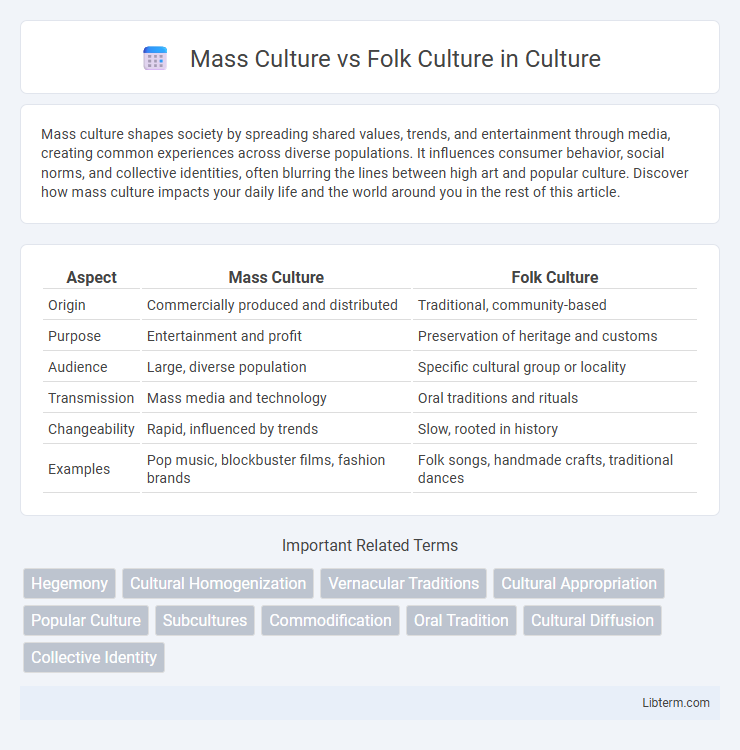Mass culture shapes society by spreading shared values, trends, and entertainment through media, creating common experiences across diverse populations. It influences consumer behavior, social norms, and collective identities, often blurring the lines between high art and popular culture. Discover how mass culture impacts your daily life and the world around you in the rest of this article.
Table of Comparison
| Aspect | Mass Culture | Folk Culture |
|---|---|---|
| Origin | Commercially produced and distributed | Traditional, community-based |
| Purpose | Entertainment and profit | Preservation of heritage and customs |
| Audience | Large, diverse population | Specific cultural group or locality |
| Transmission | Mass media and technology | Oral traditions and rituals |
| Changeability | Rapid, influenced by trends | Slow, rooted in history |
| Examples | Pop music, blockbuster films, fashion brands | Folk songs, handmade crafts, traditional dances |
Defining Mass Culture and Folk Culture
Mass culture refers to the set of cultural products, values, and practices that are widely disseminated through mass media and commercial channels, designed to appeal to large, diverse audiences. Folk culture encompasses traditional customs, practices, stories, and arts passed down through generations within specific communities, often reflecting localized heritage and identity. While mass culture emphasizes uniformity and mass consumption, folk culture preserves uniqueness and communal origins through oral traditions and localized expression.
Historical Origins and Evolution
Mass culture originated during the Industrial Revolution as urbanization and mass media facilitated widespread dissemination of standardized cultural products, contrasting with folk culture's roots in localized, rural communities preserving traditional customs through oral transmission. Folk culture evolved organically over centuries, deeply embedded in communal practices, rituals, and natural environments, often resisting rapid change. The 20th century's technological advancements accelerated the dominance of mass culture, fostering global uniformity while threatening the continuity of distinct folk cultures.
Key Characteristics of Mass Culture
Mass culture is characterized by standardized, widely disseminated cultural products designed for mass consumption through mass media channels such as television, film, and the internet. It promotes homogeneity, commercialism, and passive consumption, often driven by consumerism and popular trends rather than traditional or local values. This culture tends to emphasize entertainment, convenience, and accessibility, contrasting with the unique, community-based, and orally transmitted practices found in folk culture.
Key Characteristics of Folk Culture
Folk culture is characterized by its traditional practices, often passed down through generations within small, homogeneous groups. It emphasizes localized customs, oral traditions, and handcrafted artifacts, reflecting a strong connection to the natural environment and communal identity. Folk culture typically resists rapid change, preserving unique dialects, rituals, and folk art that convey historical and cultural heritage.
Modes of Transmission and Communication
Mass culture relies heavily on mass media platforms such as television, radio, and the internet for widespread dissemination, enabling rapid and uniform transmission of cultural content to large, diverse audiences. Folk culture is primarily transmitted through oral traditions, communal gatherings, and direct interpersonal communication, preserving localized customs and practices within tight-knit communities. The modes of transmission in folk culture emphasize personal interaction and generational continuity, whereas mass culture depends on technology-driven, impersonal communication channels that facilitate broad accessibility and instantaneous sharing.
Influence of Technology and Media
Mass culture is significantly shaped by technology and media, enabling widespread dissemination of standardized content through television, internet, and social media platforms. Folk culture relies on localized, traditional methods of communication, often transmitted orally or through community rituals, preserving unique cultural identities. The contrast highlights how digital technology and mass media drive cultural uniformity, while folk culture resists homogenization through intimate, sustained local interaction.
Impact on Identity and Community
Mass culture shapes identity by promoting homogenized values and consumer behaviors driven by global media, often diluting unique cultural traits. Folk culture reinforces community bonds through shared traditions, customs, and localized practices that foster a strong sense of belonging and historical continuity. The interplay between mass culture and folk culture influences how individuals negotiate their personal and collective identities in increasingly interconnected societies.
Globalization and Cultural Homogenization
Mass culture promotes cultural homogenization by spreading standardized products, media, and values worldwide through globalization, often diminishing unique folk cultures. Globalization facilitates the rapid exchange of mass-produced cultural elements, leading to the erosion of localized traditions and customs that characterize folk culture. The dominance of mass culture challenges the preservation of cultural diversity, as global markets prioritize uniformity over distinctive indigenous practices.
Preservation and Transformation of Folk Culture
Mass culture often leads to the homogenization and commodification of traditional practices, posing challenges to the preservation of authentic folk culture. Folk culture undergoes transformation through adaptive reinterpretation, integrating modern elements while maintaining core customs and rituals to sustain cultural identity. Efforts to document, teach, and celebrate folk traditions in community settings play a crucial role in safeguarding intangible cultural heritage amid the rise of global mass culture.
Debates and Critiques in Contemporary Society
Debates surrounding mass culture versus folk culture center on issues of authenticity, commercialization, and cultural homogenization, with critics arguing that mass culture often dilutes traditional practices and values. Scholars highlight how mass culture, driven by media conglomerates and consumerism, tends to prioritize profit over cultural significance, leading to a loss of diversity and local identity. Conversely, defenders of mass culture emphasize its role in democratizing cultural access, creating shared experiences across diverse populations while folk culture remains a vital repository of unique traditions and communal heritage.
Mass Culture Infographic

 libterm.com
libterm.com